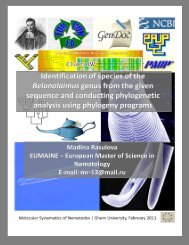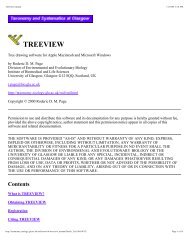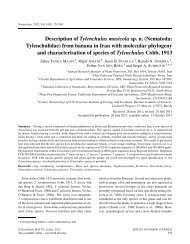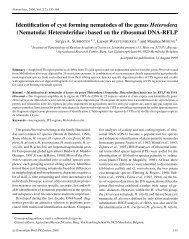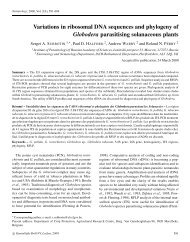Radopholus arabocoffeae sp. n. (Nematoda ... - Donimabe.org.vn
Radopholus arabocoffeae sp. n. (Nematoda ... - Donimabe.org.vn
Radopholus arabocoffeae sp. n. (Nematoda ... - Donimabe.org.vn
You also want an ePaper? Increase the reach of your titles
YUMPU automatically turns print PDFs into web optimized ePapers that Google loves.
<strong>Radopholus</strong> <strong>arabocoffeae</strong> <strong>sp</strong>.n.fromVietnam<br />
were sequenced using the BigDye Terminator v3.1 Cycle<br />
Sequencing Ready Reaction Kit according to manufacturer’s<br />
instructions (PE Applied Biosystems, Foster<br />
City, CA, USA). The resulting products were purified using<br />
a Centriflex Gel Filtration Cartridge (Edge Biosystems,<br />
Gaithersbugs, MD, USA) before being analysed using<br />
an ABI Prism 310 Genetic analyser. The ITS sequence<br />
of R. <strong>arabocoffeae</strong> <strong>sp</strong>. n. is deposited at GenBank under<br />
accession number AY547297. The DNA sequences of<br />
both <strong>Radopholus</strong> populations from coffee were aligned<br />
using ClustalX 1.64 (default options) together with six<br />
sequences of R. similis from GenBank (Elbadri et al.,<br />
2002) and two sequences of R. duriophilus (Nguyen et<br />
al., 2003). The alignment is available upon request to the<br />
corre<strong>sp</strong>onding author. Equally weighted maximum parsimony<br />
(MP) analysis was performed using PAUP* 4.0 beta<br />
version (Swofford, 1998). Gaps were treated as missing<br />
data. Bootstrap analysis was calculated with 1000 replicates<br />
for MP tree. Pairwise divergences between taxa were<br />
computed by PAUP* as the absolute distance values and<br />
the percent mean distance values adjusted for missing<br />
data.<br />
MULTIPLICATION ON CARROT DISKS<br />
The in vitro multiplication of R. <strong>arabocoffeae</strong> <strong>sp</strong>. n. was<br />
compared with that of R. duriophilus in two experiments.<br />
In the first, 25 females were randomly picked with a needle<br />
and transferred into a drop of sterile water on the cortex<br />
of a peeled and ethanol-sterilised carrot disk placed<br />
in a 3.5 cm diam. Petri dish. The Petri dishes were then<br />
sealed with Parafilm and incubated in the dark at 15, 20,<br />
25, 28, or 30 ◦ C. There were eight to 12 replicates for each<br />
<strong>sp</strong>ecies and temperature combination. The second experiment<br />
was similar to the first, but differed in the number of<br />
nematodes used and their developmental stage. One hundred<br />
mature females or juveniles of each of both nematode<br />
<strong>sp</strong>ecies were individually inoculated on carrot disks as described<br />
above and incubated in the dark at 28 ◦ C. In both<br />
experiments the nematodes were extracted from carrot<br />
disks 50 days after inoculation. The disks were macerated<br />
in 600 ml water in a Waring blender (Global Researches<br />
Inc., Winsted, CT, USA) for 30 s and the obtained su<strong>sp</strong>ension<br />
was passed through a 250 µm pore sieve. The<br />
nematodes were separated from the remaining carrot tissue<br />
in an automated nematode extraction apparatus (Hendrickx,<br />
1995). Eggs, juveniles, males and females were<br />
counted separately. As the nematode numbers were not<br />
normally distributed, they were log 10 (x + 1) transformed<br />
before ANOVA. Population increase was expressed as reproduction<br />
factor (= final nematode number/number of<br />
nematodes inoculated). Means were statistically analysed<br />
using the Duncan Multiple Range Test (P 0.05).<br />
DAMAGE POTENTIAL ON COFFEE<br />
Coffee (C. arabica cv. Catimor) seedlings were grown<br />
from seeds obtained from the Coffee Research Station<br />
in Dak Lak, Vietnam. Seeds were surface sterilised<br />
(30 min in 5.25% NaOCl) and germinated in sterile<br />
vermiculite (2 months). Just before two cotyledons had<br />
fully developed, seedlings were transferred individually to<br />
a 250 cm 3 pot filled with autoclaved soil (loam and sand<br />
70:30). The plants were kept in the glasshouse for 30 days<br />
before inoculation with mobile stages of R. <strong>arabocoffeae</strong><br />
<strong>sp</strong>. n., R. duriophilus, orP. coffeae at densities of 0, 1, 2,<br />
4, 8, 16 or 32 nematodes/cm 3 soil. Each combination of<br />
nematode <strong>sp</strong>ecies-density was replicated five times. After<br />
nematode inoculation, the nematode-treated and control<br />
plants were grown for an additional 3 months in the<br />
glasshouse with an illumination regime of 12 h light and<br />
12 h dark at 25-30 ◦ C (day) and 22-25 ◦ C (night), and 50-<br />
80% relative humidity. The plants were watered when<br />
necessary. Each month, each plant was watered with 10 ml<br />
of a liquid fertiliser (NPK 7-4-6/1000 ml). Ninety days<br />
after inoculation, the fresh root and shoot weight were<br />
determined and the final nematode population density<br />
in both soil and roots was determined after extracting<br />
the nematodes with an automatic apparatus (Hendrickx,<br />
1995). The influence of initial inoculum density on<br />
the plant development was examined using Seinfit, a<br />
computer program (Viaene et al., 1997) estimating the<br />
equation developed by Seinhorst (1965).<br />
MEASUREMENTS<br />
See Table 1.<br />
DESCRIPTION<br />
<strong>Radopholus</strong> <strong>arabocoffeae</strong> * <strong>sp</strong>. n.<br />
(Figs 1-3)<br />
Female<br />
Body almost straight or slightly curved ventrally after<br />
killing by gentle heat. Labial region continuous with<br />
body; dome shaped and bearing four or five annules.<br />
* Named after arabica coffee, the host on which the <strong>sp</strong>ecies was<br />
found.<br />
Vol. 6(5), 2004 683



